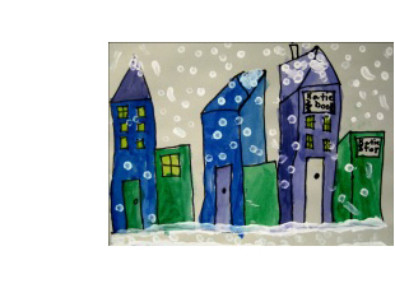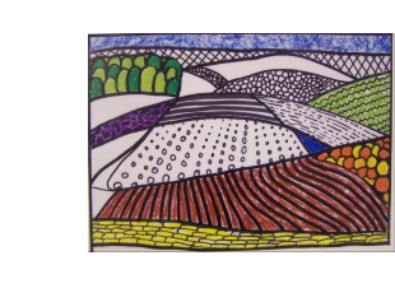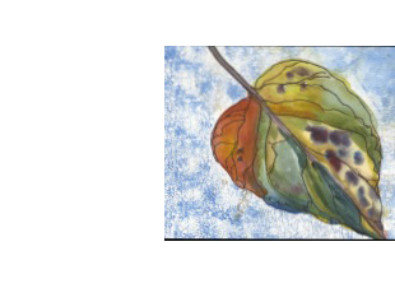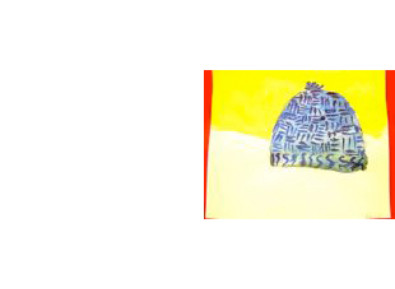Pattern Color Art Activity Elementary Kunda Indians Mola Collage
Alaskan Dinosaur Textures
This art lesson explores the scientific discoveries of dinosaurs and other prehistoric creatures found in Alaska, as well equally the important role artists play in helping united states of america to imagine what these extinct creatures may have looked similar. Students draw an Alaskan dinosaur and add crayon rubbings for texture. A torn-paper mural gives the fine art perspective.

Students are inspired by a Tlingit fable, and learn about a local seaweed scientist and artist. After learning nigh the characteristics of bull kelp, students describe bull kelp from observation on translucent paper. Colored tissue paper is added with gum and water. Finished artwork tin can be hung in the window.

Students wait at butterflies and bugs in nature to learn near symmetry. They make a symmetrical butterfly or bug.

Students create small wire and paper-thin figures, inspired by the story of American artist, Alexander Calder's, miniature circus. Figures are painted and can be hung from a line or placed in a course scene.

Students are introduced to the concept of cover-up from the volume, Vincent Van Gogh?s Cat. Each student draws a cat from observation which is colored to cover-up with a famous creative person "environment." The finished cats are graphed and students solve math word problems about cats.

Characters in our Community
Characters in our Community
In this lesson, students become familiar with the artwork of Rie Muñoz, a well-known Alaskan artist. They sketch and so pigment a real person or animal they know in their communtiy. This lesson reinforces beginning watercolor skills, working wtih the brush and using the paints responsibly. It celebrates the children'due south reflection of their community.

Charles Stonemason Photography
Charles Stonemason Photography
Students examine the piece of work of Fairbanks photographer Charles Mason and brand a humorous collage, combining multiple images they unify with charcoal grey tone techniques to simulate black and white photography.

Chimpanzees and Jane Goodall
Chimpanzees and Jane Goodall
Students study Dr. Jane Goodall and her work with chimpanzees. They acquire about the environment they live in and larn to draw a chimpanzee in its natural habitat.

Students work together to create a crayon resist replica of Preston Singletary's glass house screen which tin can be displayed in a classroom window. They learn the nuts of "Formline design," the primary blueprint format of the Northwest Declension Native cultures. A mini clan house model provides the class with noesis about traditional association houses in preparation for a visit to the Walter Soboleff Building in Juneau.

Students learn that clay comes from the earth, and becomes pottery when estrus is added. Students are inspired by photos of cultural masks. They create a clay mask molded from their face. They add together texture and color focusing on symmetry, embellishing with primary or secondary underglaze colors.

The book No Ane Can Always Steal Your Rainbow by Barbara Meislin is used for inspiration. The students create a "peace" mural by designing their own rainbow on 'puzzle pieces' and assembling into a class mural. Each pupil writes a wish for the globe and the wishes then get function of the art.
A Community Made with Lines
Students explore how buildings comprise many elements of lines in walls, doors, windows, arches, etc. They use tools to print straight and curved lines to create their own buildings, which can be part of a community.
A Community Made with Lines
Students explore how buildings comprise many elements of lines in walls, doors, windows, arches, etc. They use tools to print straight and curved lines to create their own buildings, which can be part of a community.
-8k4n3f.jpg)
Cooperative Nature Murals
Cooperative Nature Murals
Students learn nigh Mexican muralist Diego Rivera, who incorporated everyday life in his mural themes. Choosing one of two nature themes, students create a cooperative landscape depicting a class beach trip, or a class hike. They use a posable people template as a guide, and draw and paint environs such as plants, animals, rocks.

Drawing from Ascertainment: Butterflies
Drawing from Ascertainment: Butterflies
Student artists/scientists find and depict real butterflies. Kit includes 30 butterfly specimens. They depict the lines, shapes, patterns, color and symmetry of these amazing creatures, and record questions about collywobbles.

Cartoon from Observation: Flowers
Cartoon from Observation: Flowers
Using a real bloom to draw from, students explore how shape, color and lines are role of the flowers "language" to attract necessary pollinators.

Drawing from Observation: Seed Pods
Drawing from Observation: Seed Pods
Students observe seed pods to examine types of seed pod structure, looking for how and where seeds are stored.

Students create a "printing plate" using materials with texture. In this experience they consider shapes and make choices almost design. Session 2 is a printing workshop! Students print their design on folded paper creating a set of cards. They observe where the "focal point" of their artwork is and use their imagination to interpret their abstract designs.

Students worked together to create a map of the Juneau area, nestled in the middle of the lands of the Aak'westward Kwáan and T'aaku Kwáan.
Students map squares include unique patterns, and some of the symbols they drew into their maps evidence natural resources of the surface area.
Students maps include some of the local Tlingit identify names, such every bit downtown Juneau: "Dzantik'i Heeni," translated "Flounder at the Base of operations of the Creek."

Students wait at various examples of cultural masks, discussing symmetry and design. They then make their own symmetrical mask using paper and oil pastels.

Mirror Cartoon with Heather Hansen
Mirror Cartoon with Heather Hansen
Students watch a video of performance-artist, Heather Hansen. They work in partners to create a drawing, mirroring each others movement and marks wtih colored chalk. This lesson creates a at-home and supportive environs.

Oral Stories and Alaskan Animals
Oral Stories and Alaskan Animals
Session 1: After sharing a story backside one of Aleut artist, Alvin Amason'south artworks, students create art in his style. They choose an Alaskan animal from a personal story and use a "resist" technique with oil pastels and tempera paints.

Students are inspired past the story "Mary's Wild Winter Banquet" to make a connectedness with wild foods in Southeast Alaska. They create an fine art slice that, like the illustrations in the story, reflect both realistic depictions of wild foods, and Northwest Declension Native form line pattern.

Painted Mural with a Chop
Painted Mural with a Chop
Students are introduced to abstract art. They utilise masking tape to a big white newspaper, and so paint a cooperative mural in groups of 4 or iii, then add together texture. They remove the tape to create contrast, then each brand a personal" signature chop" or stamp to complete the landscape.

Palm Pots
Partner STEAM lesson with River Rocks science kit. Students learn how to create a uncomplicated small vessel from dirt, in the palm of their hand. Clay is made of the tiniest particles of rocks and other natural matter. The pots are decorated with sand and glaze and glass, all made from sand. Firing in a kiln is required.
Palm Pots
Partner STEAM lesson with River Rocks science kit. Students learn how to create a uncomplicated small vessel from dirt, in the palm of their hand. Clay is made of the tiniest particles of rocks and other natural matter. The pots are decorated with sand and glaze and glass, all made from sand. Firing in a kiln is required.

Students are introduced to Molas, the art made by the Kuna Indians from Panama. Students compare Tlingit Regalia and Kuna Molas. They make a layered paper mola using Alaskan animals. Students incorporate line, colour, shape, and blueprint in their art.

Students use information about actual pictographs plant here in Alaska to exercise drawings on sandpaper with watercolor crayons. Oil pastels are used to recreate the surrounding area around the pictograph.

Students draw a self portrait. They glue colored paper puzzle shaped pieces on their cocky portrait, then color with chalk. Finally black paint is added to the important lines on their portrait, emphasizing the power of line. It is a Tlingit value to give credit to those who teach or mentor. Students gave credit to people who taught or influenced them, and a special place.

Students are inspired by an instructional video of Juneau performing creative person, Ryan Conarro. Students cull a grapheme from a Filipino folktale "Why Mosquitos Buzz Around our Ears," follow instructions for making a shadow puppet, and participate in a brief functioning with a sheet and light (provided.) This lesson prepares students for further cosmos and use of shadow puppets.

Students create "shaveroonies"-- imaginative creatures from outer infinite. They are made past cutting paper (shaving information technology), texturing the pieces and piecing them together into fanciful creatures.

Skiiers: Colors of the Arctic Wintertime Games
Skiiers: Colors of the Arctic Wintertime Games
Students create dioramas for a paper-sculpture skiier outfitted in a race adapt designed by students. All suit colors correspond to an Arctic Winter Games team. Students will position their skiers in activity poses to best evidence off their unique adjust designs. Accessories, such as warm hats, glasses and raccing bibs are added to individualize the team skiers and extend educatee's artistic efforts.

Students are inspired Uri Shulevitz's Caldecott award winning illustrations from his volume titled, Snow. Students depict geometric shapes with a black mark to create a hamlet, and then choose a colour scheme, and paint the village with h2o color paints. Finally, tempera paint is practical with a cotton swab to portray a "snow village."

Story in a Bag (Drama kit)
Story in a Bag (Drama kit)
This drama lesson explores collaborative storytelling through improvisation. By following a Story Spine to teach bones story structure, students are guided by the instructor/narrator in creative dramatic play to invent character and plot within a setting.
Students identify dissimilar kinds of lines in famous artworks. They create a continuous line abstract drawing. They embellish the drawing with colored markers. Students proper noun their embellished line art and write near their "Story Line."

Students discuss what is 2- and 3- dimensional and what defines a sculpture. They look at examples of art in their community. Students create a pocket-sized free-standing sculpture based on a story (any good story will do.) This is a model of a larger sculpture they are proposing to build for an imaginary new library.
Students study Grant Forest and look at his unique paintings of Iowa. They then draw a landscape, texture and pattern information technology and add together color sparingly to complete their art.

Students play some simple string games to learn vocabulary words for directions and types of lines. They describe lines seen in photos and in artworks. Students use a simple line printing method press straight and curved lines. Students create a design of either an invention that contains uncomplicated machines, or buildings.

Students use photos of beach creatures and plants, in each of 4 local southest "tidal zones" to create a mural. Groundwork texture is added with rubbing plates and creatures are drawn with oil pastels.

Students examine Van Gogh paintings of landscapes paying detail attending to near and far. They larn that size and placement of trees are of import to testify perspective. Afterwards learning to draw basic tree forms, students create a landscape that shows perspective using markers and oil pastels.

Students practice watercolor techniques and colour mixing using primary colors and creating a color bike. Students draw a foliage from ascertainment, and paint it implementing new skills.

Watercolor with Rie Munoz
Watercolor with Rie Munoz
Students larn about Alaskan artist Rie Muñoz. They learn watercolor techniques and proper paint brush utilise, and create a watercolor that features a watercolor "wash" and painted "texture." The story The Runaway Mitten, illustrated by Rie Muñoz, provides inspiration for the paintings.

Students learn to draw stick figures that curve and move like real people, focusing on action words that describe the movements. Students create a wire stick figure from pipe-cleaner and use this like a small artist mannequin to form into deportment that they can draw. Students create a simple volume with their drawings and embellish their wire effigy with colored wire, in

Source: https://www.juneauschools.org/en-US/elementary-art-d203e825/art-kits-f3ba5431/second-grade-art-kits-bd5d0366/second-grade-art-kits-description-links-to-lesson-plans-a602fb36